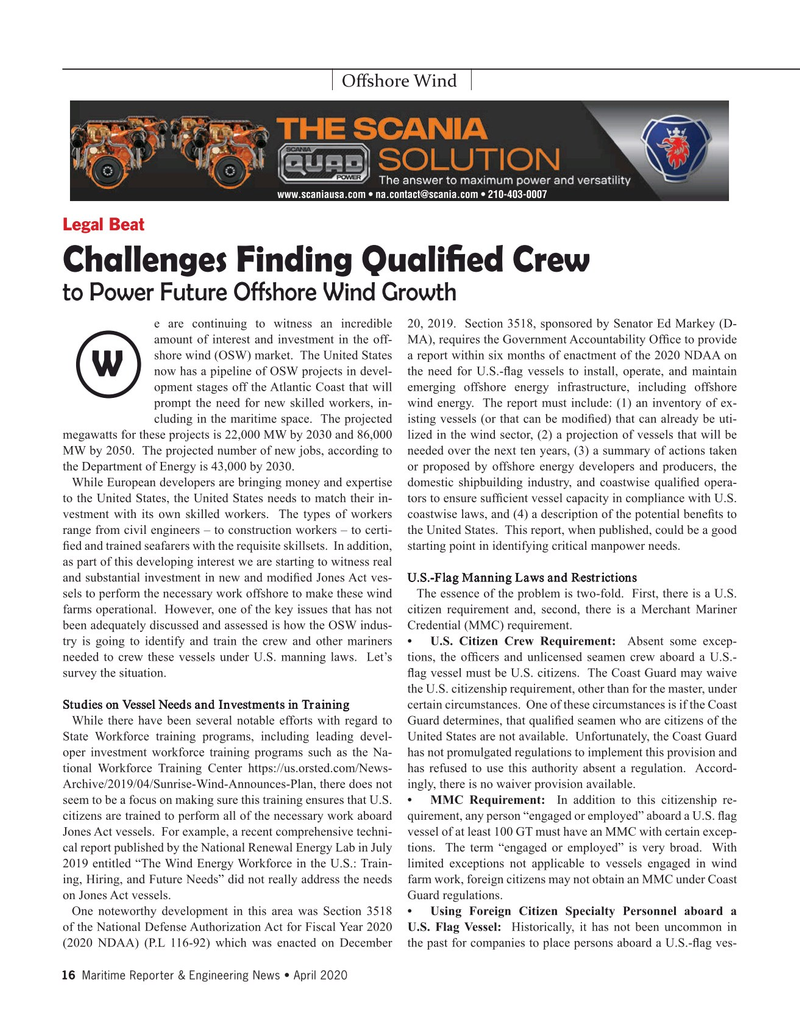
Page 16: of Maritime Reporter Magazine (April 2020)
Offshore Energy Edition
Read this page in Pdf, Flash or Html5 edition of April 2020 Maritime Reporter Magazine
Ofshore Wind www.scaniausa.com • [email protected] • 210-403-0007
Legal Beat
Challenges Finding Qualifed Crew to Power Future Offshore Wind Growth e are continuing to witness an incredible 20, 2019. Section 3518, sponsored by Senator Ed Markey (D- amount of interest and investment in the off- MA), requires the Government Accountability Offce to provide
Scania_Ad_MR April2020_B.indd 1 4/3/2020 11:19:29 PM shore wind (OSW) market. The United States a report within six months of enactment of the 2020 NDAA on now has a pipeline of OSW projects in devel- the need for U.S.-fag vessels to install, operate, and maintain
W opment stages off the Atlantic Coast that will emerging offshore energy infrastructure, including offshore prompt the need for new skilled workers, in- wind energy. The report must include: (1) an inventory of ex- cluding in the maritime space. The projected isting vessels (or that can be modifed) that can already be uti- megawatts for these projects is 22,000 MW by 2030 and 86,000 lized in the wind sector, (2) a projection of vessels that will be
MW by 2050. The projected number of new jobs, according to needed over the next ten years, (3) a summary of actions taken the Department of Energy is 43,000 by 2030. or proposed by offshore energy developers and producers, the
While European developers are bringing money and expertise domestic shipbuilding industry, and coastwise qualifed opera- to the United States, the United States needs to match their in- tors to ensure suffcient vessel capacity in compliance with U.S. vestment with its own skilled workers. The types of workers coastwise laws, and (4) a description of the potential benefts to range from civil engineers – to construction workers – to certi- the United States. This report, when published, could be a good fed and trained seafarers with the requisite skillsets. In addition, starting point in identifying critical manpower needs.
as part of this developing interest we are starting to witness real and substantial investment in new and modifed Jones Act ves- U.S.-Flag Manning Laws and Restrictions sels to perform the necessary work offshore to make these wind The essence of the problem is two-fold. First, there is a U.S. farms operational. However, one of the key issues that has not citizen requirement and, second, there is a Merchant Mariner been adequately discussed and assessed is how the OSW indus- Credential (MMC) requirement. try is going to identify and train the crew and other mariners • U.S. Citizen Crew Requirement: Absent some excep- needed to crew these vessels under U.S. manning laws. Let’s tions, the offcers and unlicensed seamen crew aboard a U.S.- survey the situation. fag vessel must be U.S. citizens. The Coast Guard may waive the U.S. citizenship requirement, other than for the master, under
Studies on Vessel Needs and Investments in Training certain circumstances. One of these circumstances is if the Coast
While there have been several notable efforts with regard to Guard determines, that qualifed seamen who are citizens of the
State Workforce training programs, including leading devel- United States are not available. Unfortunately, the Coast Guard oper investment workforce training programs such as the Na- has not promulgated regulations to implement this provision and tional Workforce Training Center https://us.orsted.com/News- has refused to use this authority absent a regulation. Accord-
Archive/2019/04/Sunrise-Wind-Announces-Plan, there does not ingly, there is no waiver provision available. seem to be a focus on making sure this training ensures that U.S. • MMC Requirement: In addition to this citizenship re- citizens are trained to perform all of the necessary work aboard quirement, any person “engaged or employed” aboard a U.S. fag
Jones Act vessels. For example, a recent comprehensive techni- vessel of at least 100 GT must have an MMC with certain excep- cal report published by the National Renewal Energy Lab in July tions. The term “engaged or employed” is very broad. With 2019 entitled “The Wind Energy Workforce in the U.S.: Train- limited exceptions not applicable to vessels engaged in wind ing, Hiring, and Future Needs” did not really address the needs farm work, foreign citizens may not obtain an MMC under Coast on Jones Act vessels. Guard regulations.
One noteworthy development in this area was Section 3518 • Using Foreign Citizen Specialty Personnel aboard a of the National Defense Authorization Act for Fiscal Year 2020 U.S. Flag Vessel: Historically, it has not been uncommon in (2020 NDAA) (P.L 116-92) which was enacted on December the past for companies to place persons aboard a U.S.-fag ves- 16 Maritime Reporter & Engineering News • April 2020

 15
15

 17
17
